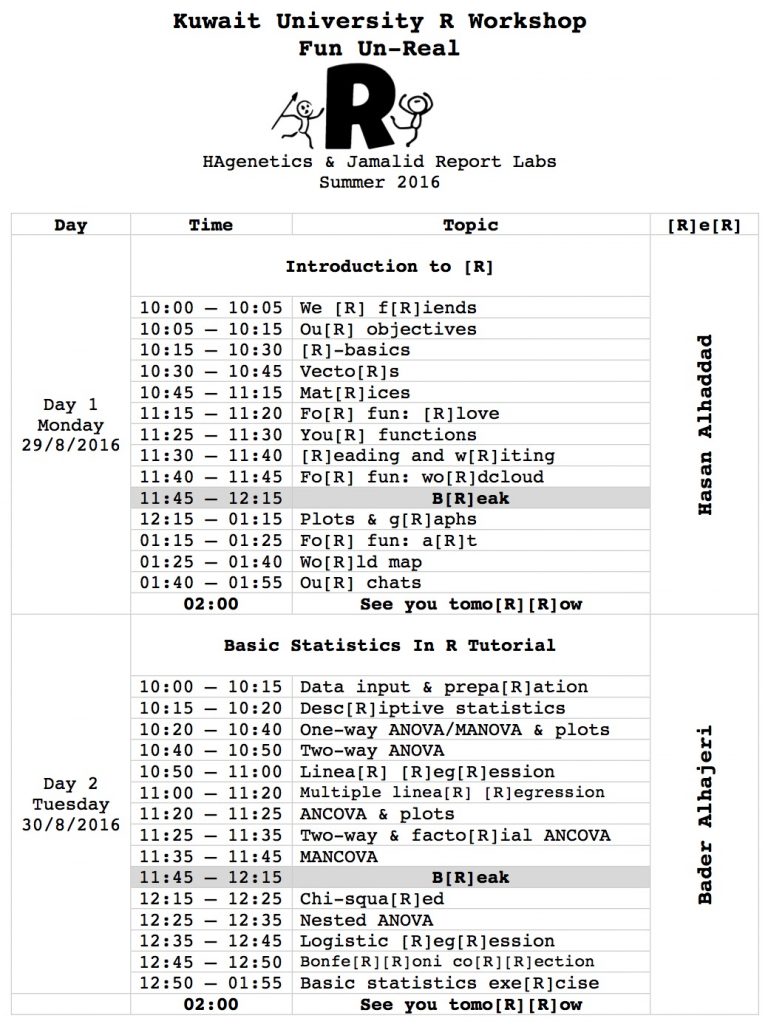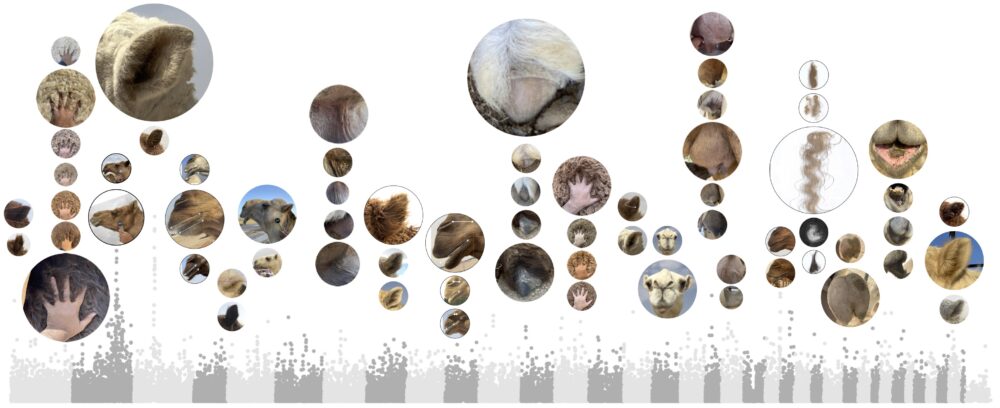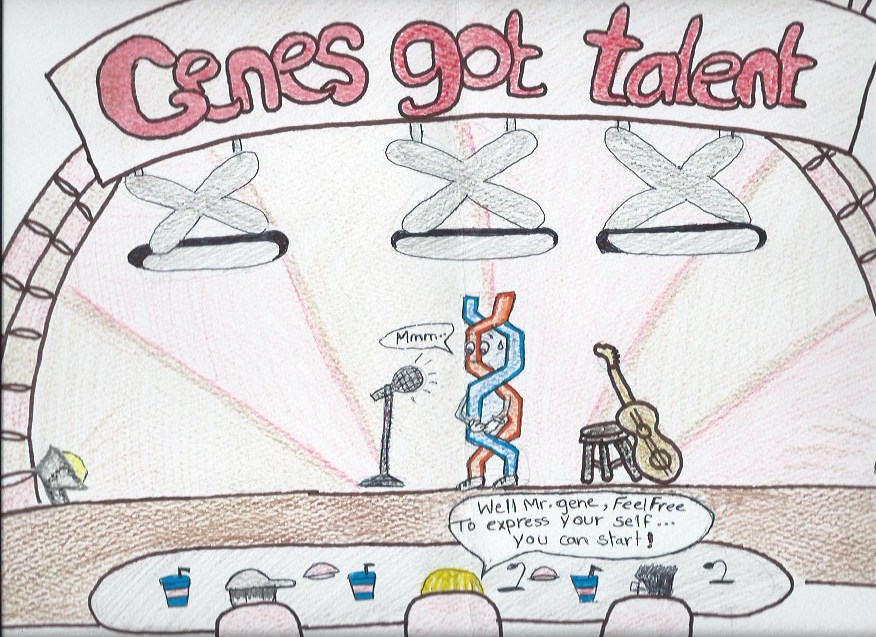
Author Archives: Hasan
Fall 2016 899km
- مد رجولك على قد لحافك وانسخ ال (RNA) على قد ال (DNA).
ريهام جابر (281)
- ال (Transposable elements) مثل ناقة عريمان. ناقة عريمان إن بركت ما ثارت (inactive) وإن ثارت نارت (active).
عباس كرم (485)
- الي بالجدر يطلعه الملاس، والي بال (Agarose gel) يطلعه (UV light).
نوره الزيان (281)
- أكل ومرعى وقلة صنعه (Psuedogenes).
حلا حمدان (485)
- ما أردى من المربوط إلا المفتلت وما أردى من ال (SINE) إلا ال (LINE).
- الدنيا تلاهي واحد مشغول وواحد ساهي وواحد يطق حنك ويشرب شاهي. عرفتوه؟ (Psuedogene).
- ال (Virus) زي أبليس ما يعرف الجمعة من الخميس. يقتل القتيل ويمشي بجنازته.
- اللي ما يعرفك ما يثمنك واللي ما يعرف ال (ATG) يقول (Stop codon).
فجر صباح (485)
- كل حب يطلع على بذره وكل (mRNA/protein) يطلع على ال (DNA) ماله.
- إلي ما له أول ما له تالي وإلي ما له (Contig) ما له (Scaffold).
- عتيج الصوف (Sanger Sequencing) ولا يديد البريسم (NGS).
- ال (Vector) وال (DNA insert) مثل السمن على العسل.
- كل ما زاد تبارك و كل ما زاد ال (coverage) تبارك ال (genome).
- Be strong like a Helices, be passionate like a Ligase, and work hard like a Polymerase
هاجر عدنان (485)
- تمنينا الطفرات (mutations) عون بس للأسف أغلبهم فرعون.
- لا تصير مثل ال (SSB) تنشب حالك بين خلق الله (DNA strands).
- دايماً خليك مثل ال (DNA Pol III) دوم شايف جدام ولا تصير مثل ال (DNA Pol I) يخطي خطوة للخلف عشان يتقدم.
- ما في أحد مثالي حتى (DNA Pol proofreading) بعض المرات يغلط.
- ال (DNA Pol) وال (3’-OH) مثل رقيه وسبيجه ما يحلون إلا مع بعض.
- في ناس مثل ال (Helicase) فيهم شر يحبون يخربون العلاقات بين شخصين.
- في جينات يبون يسافرون حق الصيف وين راحو؟ (CpG) عشان يتحفزون.
منيره الصباح (281)
Visual 899km by Hala Hamdan (Fall 2016)
Trip to Abdili 12/11/2016
Dr. Bader Alhajeri and I visited Alotham farm in Abdili, Kuwait. Adel Alothman, a recent graduate of the Zoology program, arranged the trip to his family farm. We collected hair samples for our Cdrom archive and examined our instruments for body measurements. We thank Alothman family for allowing us to sample their camels. We thank Abo Mohammed, the camel handling worker, for his patience and help for three hours.
Trip summary:
1) Young camels are harder to sample
2) Spend few minutes talking to the camel before collecting body measurements J to calm the camel
3) Noticeable differences in hair texture and length between camels especially between Wadh and Sufor
Hasan Alhaddad

Dealing with your thesis at KU
I have asked Ikhlas Mohammed (a recent graduate of the biochemistry master’s program and a student of Dr. Jamillah Zamoon) to write a detailed summary of her experience as a graduate student at KU and a guide for future graduate students. Below is what Ikhlas sent to me (un-edited). Thanks Ikhlas!
Your guide for dealing with necessary nonsense work, when in doubt call 24987385 which is the graduate school number for instructions
- When you are done with 12 credits register for Thesis 1 the next semester.
- In the same semester as your first time registration for Thesis 1 hand in:
- AC1 (deadline is 3 weeks after start of semester) and
- AC2 which includes the proposal & the 1000 KD (deadline 5 weeks after start of the semester)
- Both forms should be given to the graduate secretary Lena and she will deliver them to the graduate school but do follow up with her
- Next semester register for Thesis 2 and plan to submit the 5000 KD proposal
- Continue to register for thesis 2 even on your final semester, and once you reach your final semester (go to graduate college 2nd floor and see the dates for the graduate committee, these are the days by which if you don’t hand in everything you will not be considered for graduation till the next committee meeting which should be fine unless you finish around the summer because there is a committee in June but the next one is in Sept or Oct so you can’t graduate if you don’t catch that one) and you are ready to hand in your thesis (First let me just say congratulations that was a very very long road!! )
- Fill in AC4 (now this paper is supposedly confidential so you are only allowed to see page 1 of it)
- Collect the signature and stamp of your committee (only the signature of committee, the program director and vice dean of academic affairs signature Lena will take care of them):
- Your supervisor + 2 other academic people (the one with the higher academic rank put his/her name in the convener space and the other one in the member space).
- AC4 is handed in with your printed bound thesis + CD (that has the thesis obviously) and transcript and major sheet
- (Both transcript and major sheet you can find them from the college of graduate study room 33 transcripts require 1 KWD stamp and make sure the major sheet is stamped by the employee).
- Your supervisor needs to hand the thesis, transcript, major sheet, one CD (containing thesis in both PDF and word format) include these sentences in the CD cover
Kuwait University
Title of thesis
First version
Name + student id
Department/College
Month/Year
And AC4 to Lena, which will address it to vice dean, and he will send it to the college of graduate studies.
- Once the thesis is handed in the first time it normally takes 3 days to leave the department (depending on when is the vice dean there to sign the paper) and once it reaches there, a paper will be sent to the supervisor to state that the thesis did reach them. It will take an additional 3 days for the thesis to be assessed once it is in the hand of CGS.
- Once the thesis is back (to your supervisor office) you need to make the requested changes, re-print these changed pages and remove the incorrect pages and replace them with the corrected pages (don’t throw away the incorrect pages). Then save the file in PDF format only into total of 4 CDs and together with a letter from your supervisor stating that you made the correction, the incorrect pages (for CGS to compare and make sure that you’ve made the changes), and the CGS page titled “remarks on manuscript” hand all these to the graduate school second floor the reception. Note: you can reprint the thesis if you don’t want to exchange papers, but why waste trees!
- It normally takes 2 weeks or more for the graduate school to contact the external referee and get his/her approval for the thesis to be sent to them. Don’t waste time and ask your internal committee if they want copies of the thesis so that they can read it while the wait for external reply is going on (Note: university only sends copies to internal referee once they’ve contacted the external or once the report and the thesis is back from the external (I’m not sure which option they go with, but both options are wasting time). Normally they give the external referee up to 1 week to reply if he/ she want to read the thesis in case of no reply or a negative answer they move to the next referee on the list (graduate school does arrange the 5 names on the list as they like and not as your supervisor originally wrote the names in AC4) if all 5 say no and or didn’t reply the graduate school sends a paper to your supervisor to ask him/her to provide them with 5 more names for external referee (hopefully things will not reach this point) and the process is repeated till there is a positive answer.
- In the meantime while you are waiting for the external referee report to arrive you can always review for the thesis examination, or do a departmental seminar or participate in poster day or participate in a scientific mission to present that poster or watch YouTube videos! Its your time you figure out how to use it!
- It took 2.5-3 weeks for the external examiner report to arrive
- Now fill out AC6 and hand it in to graduate college (2nd floor the reception). You need to first make the adjustment that the external referee pointed out then sign the paper from your supervisor + internal committee. It is preferred (but not mandatory) to hand in this form 2 weeks before your defense data (I hand it in 3 days before so it really doesn’t matter). For the defense time and location, you need signature of you committee, and then to specify the time and location. To book the conference hall (dean office) first talk to the administrator manager (the room next to the conference hall) to confirm that the time and the date is empty. Then take a paper from the photocopy room near (secretary taj’s room) and fill it with your name / supervisor/ today’s date/ the date you want the room and the time and which room you want) then give it to secretary taj so that she will hand it to the correct people.
- You also at the same time need to take a clearance form from graduate college 2nd floor room 33, you need to sign this paper systematically from the first to the last person, 1. The program director (Dr. Fadwa), 2. The library (the 2nd floor science library), 3. The boy’s dorm in shuwaikh, 4. Safety and security department (where you take your student id from) 5. Management department (in building 2 KH near the corridor that leads to the library) 6. Finance department (near gate 7). Also make sure that the all the signatures include a stamp (and sometimes dates too) and the stamp is repeated on the carbon copy. The next two pages can be filled by you with your details (yes the page is repeated twice but you need to fill both pages). Hand in this form to graduate college room 33 also days before your defense.
- Today is your defense day Woho, I recommend you eating a cake before the defense (or eating one after you are done or eating one before and after the defense)
- On the defense day make sure that the convener have the AC7 form and that when all members sign they also stamp and include the date, make sure to also later print 10 copies of the signature page only so that all the members can sign it and you can use these pages for your final bound thesis (and have some spares just in case). The convener should type (computer typed not hand written) the report in the second page of AC7.
- Either the convener sends the AC7 form to the secretary then from the secretary to the program director or the convener sends the AC7 form to the supervisor (who gives a copy to the secretary) and directly hands it to the program director that will send it to the graduate college. (You can send AC7 after your supervisor makes sure you have made the amendments, you don’t have to send it with the rest of the forms (Ac8-10) it is better to be send first since the printing of the thesis and binding will take some days)
- Next, save your thesis into 3 CDS (1 CD containing the thesis in both pdf and word format, another CD containing only the title page + abstract both in Arabic and English (also in both word and pdf) and a third CD containing the thesis in pdf only) Imp: make sure that the symbols, the font, the table of contents are all ok when converting to pdf. CD1 & 2 will be given later to the graduate college so set them aside.
- Next, take CD 3 (pdf only) also take the printed signed signature pages with you and go to Al Alamiah center (map attached) (phone number 22414141, Al-Rai, Al Ghazali Road – beside Electrozan (if using gps set it for electrozan because their location isn’t detectable by Google maps then walk for 100m and their door looks like a house door and go to the first floor. They calculate the number of color and non colored pages you have and ask you how many copies you need and what cover for the book to use (the cover depend on what college you belong to) then they ask you to pay some money in advance and it is up to you how much you pay in advance but better not to pay everything just in case something went wrong I’ve paid only 10% of the price in advance) to print your thesis and bound it there. You need to print 1 copy for yourself, one for the supervisor, one for CGS one for program director (Dr. Fadwa), one for the science library (joint program needs to give both libraries) and one for research administration (if you have been funded by them AC2 and they are the ones that need to sign in the AC8 in the financing source). So 5 or 6 copies (or 7 for joint programs) need to be printed there at Al Alamiah center usually take 4 or 5 working days they don’t work on Friday and they only work from 8 am to 4pm.
- In AC9 just sign part C if you took nothing from the college (software & books) also let the program director sign part B (even if you took nothing he/she needs to sign).
- In AC10 you need to attach your civil id copy and bankcard copy (add iban number) so that the university can reimburse you later for the thesis printing fees. In AC8 you need to get the signature and the stamp of all the people who are supposed to receive the thesis final form (mentioned in point 15, so one for the supervisor, one for the library one for program director (Dr. Fadwa) and one for research sector as the finance source if they did finance your thesis) give copies of the sign forms (AC 8-10 to both lena and your supervisor)
- Next take CD 1 & 2 and one signature page and AC8 to AC10 and bound thesis copy (this is for CGS) to the graduate college third floor room 10 to ester she will check if everything is ok then she will hand you back your papers and the book and any extra copies (of the old thesis for refereeing) she have, next give the cd which have the abstract + title page to room 19 (Aisha) on the same floor. She will check if it is correct and sign AC8 and takes a copy and give you back the paper now take the cd with the full thesis + (AC8-10 + signature paper and the bound thesis) to 2nd floor graduate college reception. All these papers needs to be handed 1 week before the date of the graduation committee so that you will be considered for this graduation committee.
- Next you can check with the graduate college (room 35) when you can expect your certificate to be handed to you (usually takes 1.5 months after the graduate committee meeting, also after the committee meeting date make sure to check with them to see if there are any missing papers (for example they need the paper issued by the program director/ the course professor which allowed you to take an undergraduate course)
KSA Trip #1 (4-5/11/2016)
We visited Al-Hasa, KSA on 4-5/11/2016 in order to meet Dr. Faisal Almathen at the Camel Research Center in King Faisal University (KFU). We spent the first day at the KFU School of Veterinary Medicine where we admired the amazing infrastructure projects at KFU and the facilities that aid in providing a pleasant academic atmosphere. In a meeting that lasted over three hours, we discussed with Dr. Faisal Almathen the state of camel research and the possible collaborative short and long-term projects. We spent the rest of the day exploring Al-Hasa with Dr. Fasial.
The second day was devoted to research. We drove to the Camel Research Center in the morning, where Dr. Faisal made the necessary arrangements prior to our arrival. Our main objective was to collect samples from the three available camel breeds—three individuals of each of the Megaheem, Wadh, and Sufor breeds were prepared prior to our arrival. The Megaheem camels are the dark-colored breed, whereas the Wadh are the light-colored breed, and the Sufor are the brown-colored breed. We met Dr. Watheq at the center, an expert camel researcher, along with Abdulraheem and Abo Alhasan—two camel workers who are experts at handling camels. We spent around six hours sampling the camels.
Trip summary:
1) Camels are large
2) Megaheem camels are especially huge
3) Wadh camels are relatively easier to work with
4) Hair samples are better collected from the tail than the neck (and other regions)
5) Hungry camels are whining machines
6) Camels attract a lot of flies! Get used to them
7) A team is essential for the sampling process
8) It is important to secure an escape route when working with large camels!
9) Having camels devoted for research speeds up the research process
10) Collaborations are fun, and essential
11) We had so much fun, that we plant to visit again!
We attach some photos from the visit below. We thank thank Dr. Faisal, Dr. Watheq, Abdulraheem, and Abo Alhasan for their help during our trip.
Hasan Alhaddad
Bader H. Alhajeri
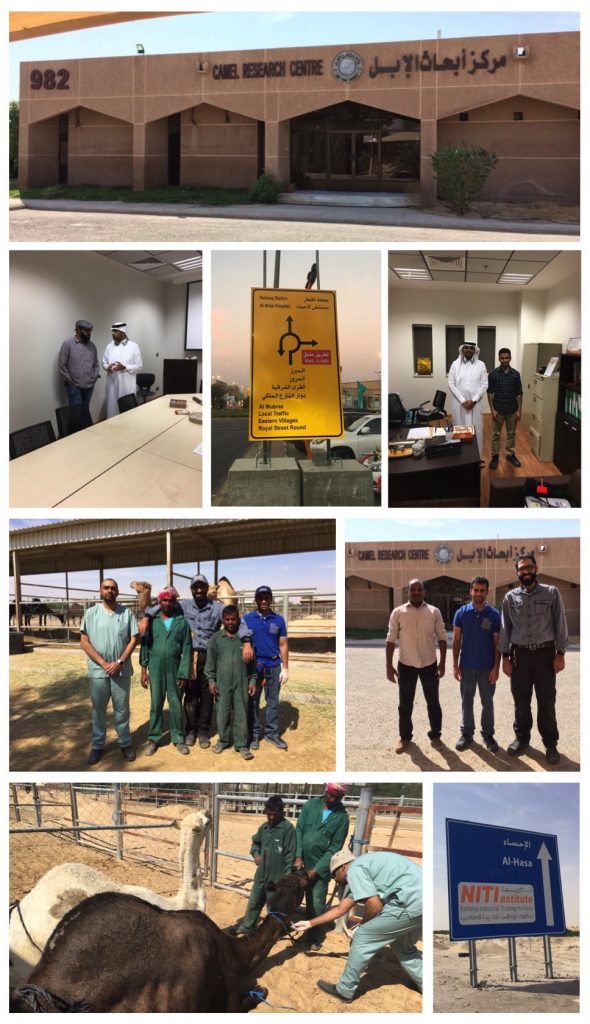
Immunology 899km by Nawal Alshammari
منذ أيام قليلة وعند بوابة المبنى الذي ألقي فيه محاضراتي رأيت إحدى طالباتي السابقات (نوال الشمري) مقبلة نحوي. كنت أظن أنها ترغب في إلقاء التحية كما هي عادة أغلب الطلبة الذين يعرفوني وأعرفهم. غير أن نوال فاجأتني بملف يحمل أوراق وقالت أنها أتت خصيصاً لهذا المبنى كي تعطيني هذا الملف. كان الملف يحوي ثلاث أعمال فنية تحاكي ما تعلمته نوال في مقرر المناعة والذي كان في الصيف الماضي. لم أتفاجأ بإبداع نوال خصوصاً وأنها في مقررين سابقين قدمت لي أعمال إبداعية مميزة. كانت المفاجأة أن العمل الإبداعي هو لمقرر لا أدرسه وفي غير تخصصي الدقيق.أسعدتني مبادرتها وأغرقني سعادةً أنها بعد اليوم لا تحتاجني كي تستمتع بما تتعلم في شتى المجالات. كانت تعتذر وتتساءل إن كنت أسمح باستقبال وتقييم أعمال من هذا النوع في خارج إطار ما أطرحه من مقررات وموضوعات. قلت لها وأقول لكل فرد مبدع يقرأ هذه الكلمات أنه شرف لي أن تشاركوني عقلكم وإبداعكم ويسعدني أن أضع أي عمل إبداعي في هذه الصفحة الإلكترونية و التي خصصتها لأعمال الطلبة المبدعين. لا شرط عندي ولا حد للإبداع أي كانت صوره. كانت على شكل رسومات أو كلمات وبأي لغة كانت. أي ابداع يكون خلاصة حب لعلم تعلمه الطلبة هو مرحب به وبشده. شكراً نوال
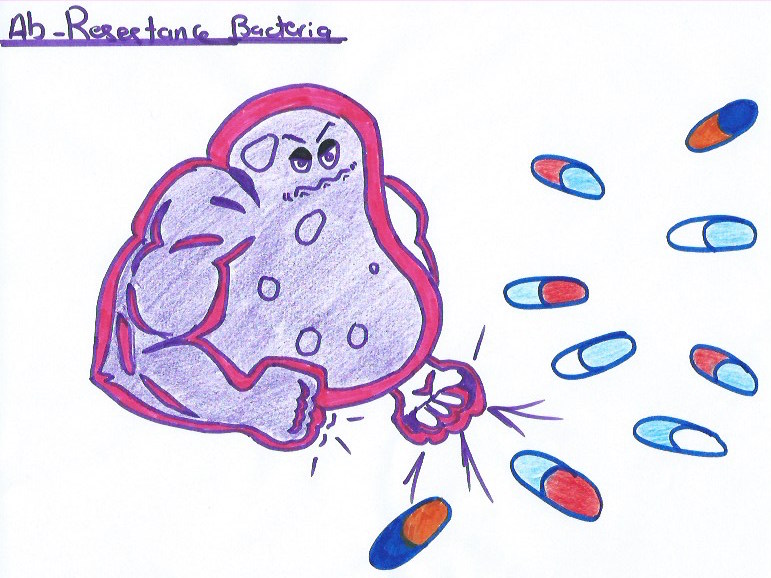
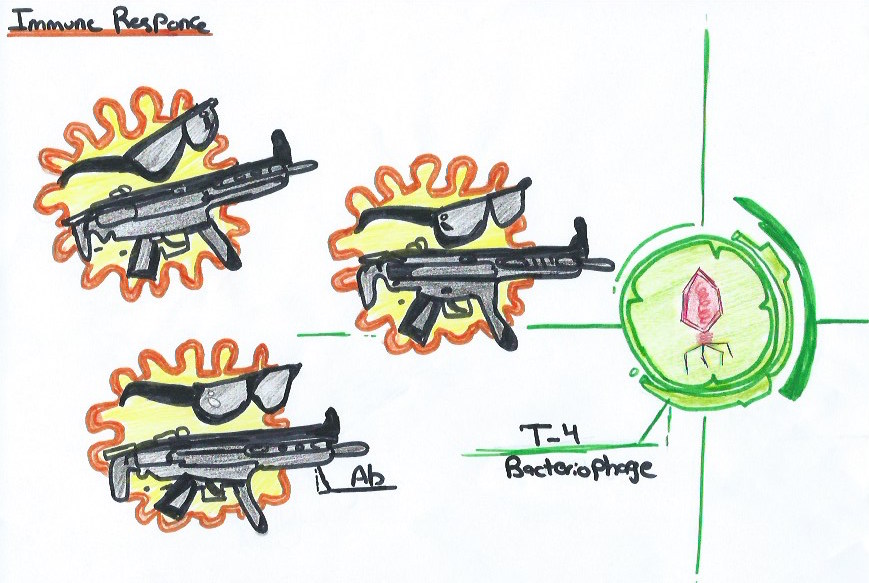
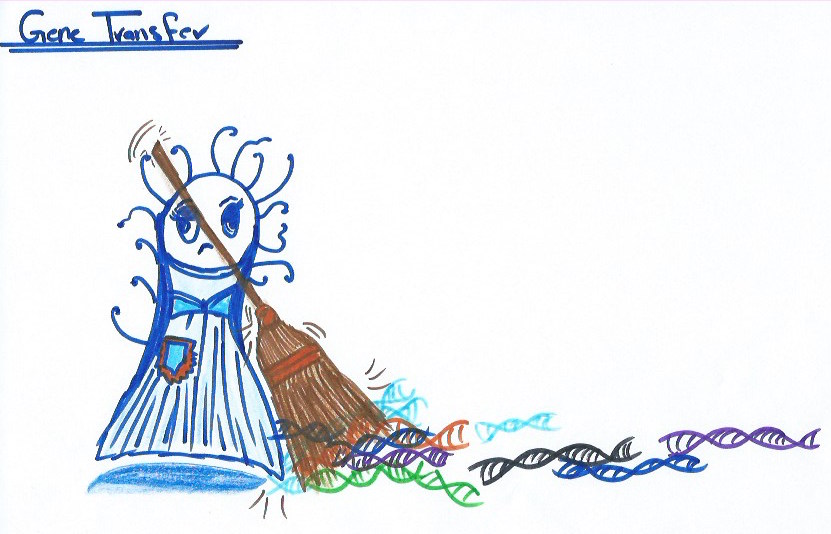
What are camelids?
What are camelids?
By: Bader H. Alhajeri
Assistant Professor of Zoology, Kuwait University
Camalids are ‘camel-like’ mammals (characterized by long legs and necks) belonging to the family Camelidae (of which Camelinae is the only extant subfamily). This group consists of three extant genera: Camelus, Vicugna, and Lama. The first genus includes both the Arabian single-humped dromedary camel: Camelus dromedaries and two species of the Mongolian two-humped Bactrian camel: Camelus bactrianus (domesticated Bactrian) and Camelus ferus (wild Bactrian)—this genus, along with extinct relatives belongs to the tribe Camelini. The other two genera consists of South American camelids: the alpaca (Vicugna vicugna and Vicugna pacos) and the Llama (Lama glama and Lama guanicoe), both of which belong to the tribe Lamini.
As part of our ongoing effort, at the Jamalid Report research group, to study the dromedary and associated camelids, during my most recent visit to the United States Museum of Natural History (in August 2016), I spent some time examining the camelid skeletons housed at their Museum Support Center. The Support Center is a facility that houses >54,000,000 items of the Smithsonian’s collection, that are not on display. I am grateful to Mr. Darrin Lunde, the USNM Mammals Collection Manager, for arranging this visit. The examination of the camelid skeletons gave me an appreciation for the similarities (and differences) that occur in this group—I was especially struck by the extensive similarities in the crania and dentition. This experience was insightful, and will undoubtedly prove useful, in our ongoing exploration of this interesting, yet relatively understudied, group—the first step of which consists of examining the extent of morphological (and molecular) variation in dromedary camel breeds.
Pictures of some of the camelid skeletons examined at the USNM collection follow.
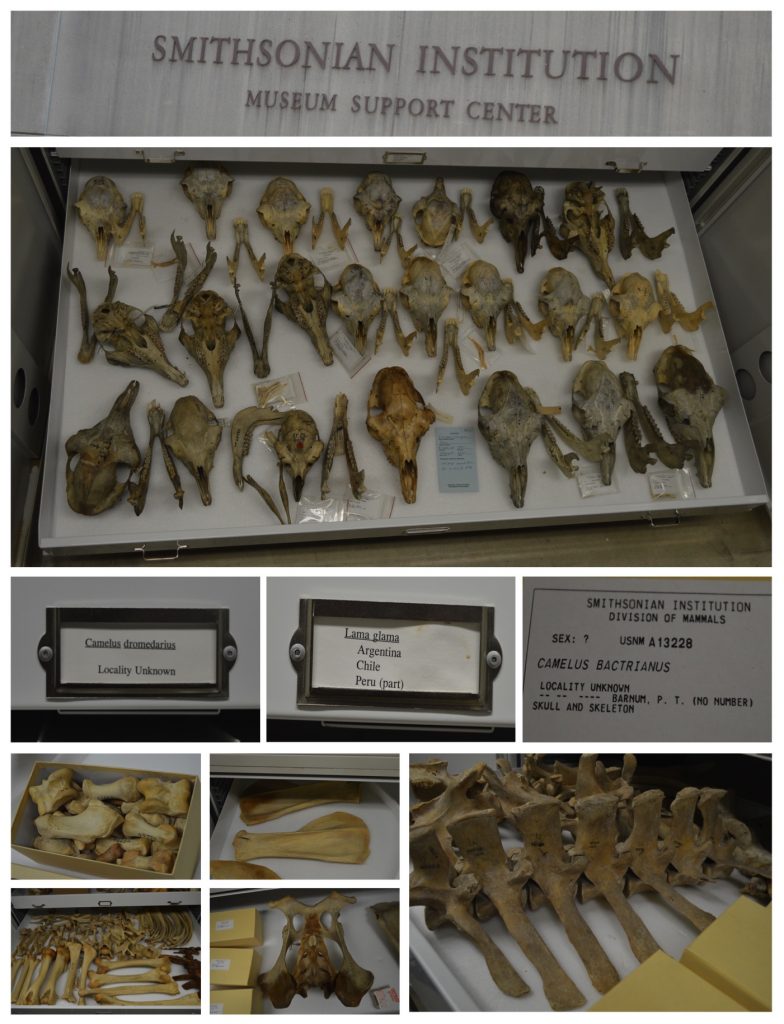
EHRAB Fall 2016
EHRAB this year will be different from previous years. The focus will be on camelid books and papers. The plan is to meet every week on Monday and at 12:30. EHRAB will be held in the Jamalid Report lab (1 Kh room 150). Throughout the semester we will read a book chapter and a peer-reviewed papers in alternating fashion. Below are the dates and the reading material. If you are interested in joining us in reading the book chapters of Medicine and Surgery of Camelids by Murray Fowler, please don’t hesitate to send me (hhalhaddad@gmail.com) an email to get the material.
Monday Oct 10: Chapter 1- General biology and evolution
Monday Oct 17:
Computed Tomographic Anatomy of the Fore Foot in One-Humped Camel (Camelus dromedrus). by Adel M. Badawy
Magnetic Resonance Imaging of the One-Humped Camel (Camelus Dromdarius) Digits. by El-Shafey and Abd Al-Galil.
Monday Oct 24: Chapter 2- Feeding and Nutrition
Monday Oct 31:
Production of the First Cloned Camel by Somatic Cell Nuclear Transfer. by Wani et al.
Monday Nov 7: Chapter 3- Restraint and Handling
Monday Nov 14:
Monday Nov 21: Chapter 4- Clinical Diagnosis
Monday Nov 28:
Monday Dec 5: Chapter 5- Anesthesia
Monday Dec 12:
Ancient and modern DNA reveal dynamics of domestication and cross-continental dispersal of the dromedary. by Almathen et al.
TBA
Monday Dec 19: Chapter 6- Surgery
Monday Dec 26:
TBA
TBA
Monday Jan 2 / 2017: Chapter 7- Infectious diseases
Monday Jan 9 / 2017:
TBA
TBA
KURwFUR 2016 program
Our detailed program for the 3 days workshop is available to be viewed and downloaded (2016_KURwFUR_program)
